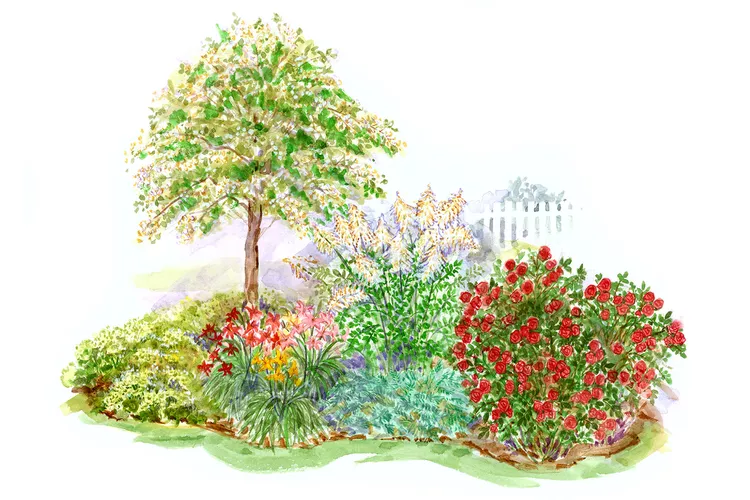This Clay Soil Garden Plan Will Thrive Even in Tough Conditions

Gardening in clay soil can be a bit like planting in concrete. This dense earth drains poorly after rain, and when it does eventually dry, the surface becomes frustratingly hard and crusty. But this clay soil garden plan will enable you to enjoy a colorful, thriving garden, despite your challenging soil conditions. Use the plant list and layout plant below to create this garden in your own yard.
Plants for Creating the Clay Soil Garden Plan
The mix of plants in this design can handle (even thrive in) the tough conditions common to clay soil. Among the selections are a hawthorn tree, a rugosa rose, lady's mantle, and daylilies, all of which will produce beautiful blossoms at different times of the year. You can swap in the alternative plant suggestions to customize the garden to your liking, or even expand and diversify this mixed bed over time.
- 1 Thornless hawthorn (Crataegus crusgalli inermis); Alternative Plant: River birch (Betula nigra 'Heritage')
- 3 'F.J. Grootendorst' roses (Rosa rugosa 'F.J. Grootendorst'); Alternative Plant: Red chokeberry (Aronia arbutifolia 'Brilliantissima')
- 1 'Blue Mat' juniper (Juniperus horizontalis 'Blue Mat'); Alternative Plant: 'Anthony Waterer' spirea (Spirea x bumaldi 'Anthony Waterer')
- 7 Lady's mantle (Alchemilla mollis); Alternative Plant: Lance leaf hosta (Hosta lancifolia)
- 1 Goatsbeard (Aruncus dioicus); Alternative Plant: Northern sea oats (Chasmanthium latifolium)
- 3 Daylily hybrids (Hemerocallis); Alternative Plant: Siberian iris (Iris siberica)
If you aren't able to find the exact cultivars listed above, substitute with others that have similar colors, shapes, and sizes.
Since some plants can become overly aggressive and spread uncontrolled in certain climates, always check which species are considered invasive in your area before planting. For example, rugosa roses can be problematic in coastal areas throughout New England, the Pacific Northwest, and the Great Lakes, so if you live in these regions, you may want to replace this plant in the plan with the suggested alternative, 'Brilliantissima' red chokeberry.
Download the Free Clay Soil Garden Plan
This garden design includes an illustrated version of the planted garden, a detailed diagram of the layout, a list of plants for the garden as shown, and complete instructions for installing the garden.